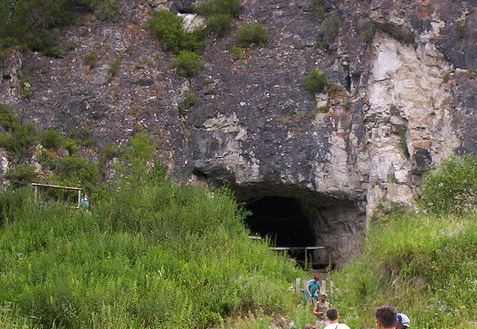Recently, a Neanderthal toe bone yielded enough DNA to sequence the full genome of the woman whose remains were found in the Denisova Cave in the Altai Mountains, shown above. This information was…

dna-explained.com
Recently, a Neanderthal toe bone yielded enough DNA to sequence the full genome of the woman whose remains were found in the Denisova Cave in the Altai Mountains, shown above. This information was published in the Journal Nature in an article titled “
The complete genome sequence of a Neanderthal from the Altai Mountains” by Prufer et al. I wrote about what was found
here, but it wasn’t until I really read the 200+ pages of supplemental information that I found additional buried information.
The article itself talks about some of the findings relative to Native Americans, but the supplemental information provides additional detail and the supporting charts.
In the paper, the Mixe and the Karitiana people of Mexico and Brazil, respectively were most often used to represent Native Americans. There are about 90,000 Mixe language speakers alive today, so their population is not small. However, the Karitiana are just the opposite, with only about 320 people in a very remote region of Brazil. The Karitiana shun contact with outsiders. In some parts of this study, additional population groups were used for additional Native samples.
Here’s what the article itself has to say about Neanderthals, Denisovans and Native Americans.
Denisovan gene flow in mainland Asia
We used the two high-coverage archaic genomes and a hidden Markov model (HMM) to identify regions of specifically Neanderthal and specifically Denisovan ancestry in 13 experimentally phased present-day human genomes (Supplementary Information sections 4 and 13). In the Sardinian and French genomes from Europe we find genomic regions of Neanderthal origin and few or no regions of Denisovan origin. In contrast, in the Han Chinese, the Dai in southern China, and the Karitiana and Mixe in the Americas, we find, in addition to regions of Neanderthal origin, regions that are consistent with being of Denisovan origin (Zscore54.3 excess relative to the Europeans) (Supplementary Information section 13), in agreement with previous analysis based on low-coverage archaic genomes. These regions are also more closely related to the Denisova genome than the few regions identified in Europeans (Supplementary Information section 13). We estimate that the Denisovan contribution to mainland Asian and Native American populations is ,0.2% and thus about 25 times smaller than the Denisovan contribution to populations in Papua New Guinea and Australia. The failure to detect any larger Denisovan contribution in the genome of a 40,000-year-old modern human from the Beijing area suggests that any Denisovan contribution to modern humans in mainland Asia was always quantitatively small. In fact, we cannot, at the moment, exclude that the Denisovan contribution to people across mainland Asia is owing to gene flow from ancestors of present-day people in Oceania after they mixed with Denisovans. We also note that in addition to this Denisovan contribution, the genomes of the populations in Asia and America appear to contain more regions of Neanderthal origin than populations in Europe (Supplementary Information sections 13 and 14).
The fascinating part of this, aside from the fact that Native people also carry both Denisovan and Neanderthal DNA, and that they carry more than Europeans, is that the Denisovan and Neanderthal DNA that they carry is different than that carried by Europeans. In fact, it appears that not all Europeans carry Denisovan DNA and this paper lowers the estimated percentage of Neanderthal for all Europeans.
This difference in the Neanderthal and Denisovan DNA might be able to help solve a long-standing mystery, and that’s whether or not part of the Native population of the Eastern seaboard, and in particular, the far Northeast part of that region, was populated by or admixed with Europeans long before the time of Columbus and other European pre-colonial explorers. This information, of course would have to come from pre-contact burials, but they do exist and with this new information in hand, they might just yield answers never before available.
Dr. Ricki Lewis, in her
DNA Science Blog, mentioned something else quite interesting culled from a Christmas Day issue of
Nature titled “Sequence variants in SLC16A11 are a common risk factor for type 2 diabetes in Mexico.” In a nutshell, from article introduction, we find this commentary:
“The risk haplotype carries four amino acid substitutions, all in SLC16A11; it is present at ~50% frequency in Native American samples and ~10% in east Asian, but is rare in European and African samples. Analysis of an archaic genome sequence indicated that the risk haplotype introgressed into modern humans via admixture with Neanderthals.”
Ricki extrapolated on this further:
“Researchers determine the degree to which a mutant gene differs from the most common sequence (wild type), then impose a time scale in the form of known mutation rates. The SLC16A11 five-site haplotype is so divergent that it goes back to nearly 800,000 years ago — before our ancestors expanded out of Africa.
The most plausible explanation, unexpected I suspect, seemed to be that the haplotype came from an archaic human – a Neanderthal or Denisovan or their as-yet unnamed contemporaries. And the haplotype indeed shows up in the skeleton of a Neanderthal found in the Denisovan cave in Siberia.”
And so, it seems that the Native American people today indeed inherited their propensity for type 2 diabetes from their ancient Neanderthal ancestors who lived in the Altai Mountains. It also appears that this genetic predisposition did not carry forward to Europe, if indeed this group of Neanderthals was ancestral to Europeans at all.

